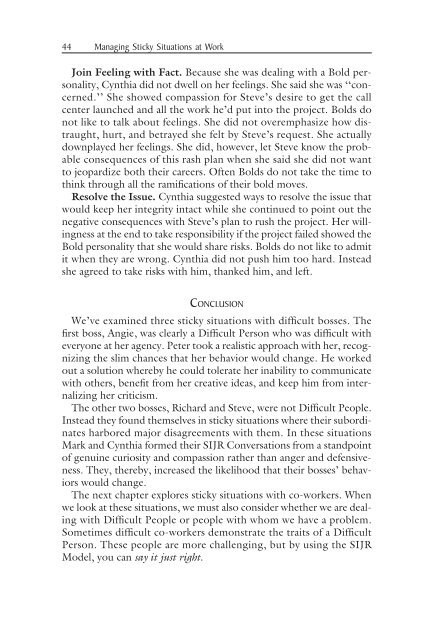Managing Sticky Situations at Work
Managing Sticky Situations at Work
Managing Sticky Situations at Work
Create successful ePaper yourself
Turn your PDF publications into a flip-book with our unique Google optimized e-Paper software.
44 <strong>Managing</strong> <strong>Sticky</strong> <strong>Situ<strong>at</strong>ions</strong> <strong>at</strong> <strong>Work</strong>Join Feeling with Fact. Because she was dealing with a Bold personality,Cynthia did not dwell on her feelings. She said she was ‘‘concerned.’’She showed compassion for Steve’s desire to get the callcenter launched and all the work he’d put into the project. Bolds donot like to talk about feelings. She did not overemphasize how distraught,hurt, and betrayed she felt by Steve’s request. She actuallydownplayed her feelings. She did, however, let Steve know the probableconsequences of this rash plan when she said she did not wantto jeopardize both their careers. Often Bolds do not take the time tothink through all the ramific<strong>at</strong>ions of their bold moves.Resolve the Issue. Cynthia suggested ways to resolve the issue th<strong>at</strong>would keep her integrity intact while she continued to point out theneg<strong>at</strong>ive consequences with Steve’s plan to rush the project. Her willingness<strong>at</strong> the end to take responsibility if the project failed showed theBold personality th<strong>at</strong> she would share risks. Bolds do not like to admitit when they are wrong. Cynthia did not push him too hard. Insteadshe agreed to take risks with him, thanked him, and left.CONCLUSIONWe’ve examined three sticky situ<strong>at</strong>ions with difficult bosses. Thefirst boss, Angie, was clearly a Difficult Person who was difficult witheveryone <strong>at</strong> her agency. Peter took a realistic approach with her, recognizingthe slim chances th<strong>at</strong> her behavior would change. He workedout a solution whereby he could toler<strong>at</strong>e her inability to communic<strong>at</strong>ewith others, benefit from her cre<strong>at</strong>ive ideas, and keep him from internalizingher criticism.The other two bosses, Richard and Steve, were not Difficult People.Instead they found themselves in sticky situ<strong>at</strong>ions where their subordin<strong>at</strong>esharbored major disagreements with them. In these situ<strong>at</strong>ionsMark and Cynthia formed their SIJR Convers<strong>at</strong>ions from a standpointof genuine curiosity and compassion r<strong>at</strong>her than anger and defensiveness.They, thereby, increased the likelihood th<strong>at</strong> their bosses’ behaviorswould change.The next chapter explores sticky situ<strong>at</strong>ions with co-workers. Whenwe look <strong>at</strong> these situ<strong>at</strong>ions, we must also consider whether we are dealingwith Difficult People or people with whom we have a problem.Sometimes difficult co-workers demonstr<strong>at</strong>e the traits of a DifficultPerson. These people are more challenging, but by using the SIJRModel, you can say it just right.















